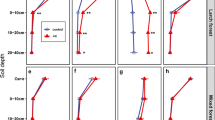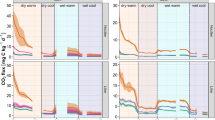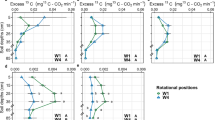Abstract
Aims
Evaluate biological nitrogen fixation (BNF) and its contribution to total N yield in different grass-clover mixtures under a boreal coastal climate and assess how winter conditions affect the survival of clover and its capability to fix nitrogen (N).
Methods
Grass-clover mixtures sown with 0, 15 and 30% red and white clover were subjected to two N rates and three levels of tractor trafficking over four years. BNF was estimated by N-difference for each of the two harvests per year, whereas the first harvest was used to estimate the fraction of N derived from the atmosphere (NdfA) and its transfer to grasses by 15N natural abundance.
Results
Biological N fixation, mainly by red clover, contributed substantially to total N yield, which was up to 75% greater in grass-clover mixtures than in pure grass stands in the second production year. However, the number of red clover plants and associated BNF decreased dramatically in the third and fourth production year, with N fertilization rate having a more detrimental effect than soil trafficking. Conversely, the amount of biologically fixed N transferred to grass, increased with time, evidencing that some of the biologically fixed N is retained in the system. In the first harvests, NdfA values were generally between 80 and 100%, irrespective of preceding winter conditions.
Conclusions
BNF in high latitude grass-clover mixtures can be substantial but is limited by the poor survival of red clover. Variable winter conditions had no measurable effect on winter survival nor on the sward’s capacity to fix nitrogen in spring.







Similar content being viewed by others
References
Anglade J, Billen G, Garnier J (2015) Relationships for estimating N2 fixation in legumes: incidence for N balance of legume-based cropping systems in Europe Ecosphere 6:1-24 doi:https://doi.org/10.1890/ES14-00353.1
Arrese-Igor C, Royuela M, de Lorenzo C, de Felipe MR, Aparicio-Tejo PM (1993) Effect of low rhizosphere oxygen on growth, nitrogen fixation and nodule morphology in lucerne. Physiol Plant 89:55–63. https://doi.org/10.1111/j.1399-3054.1993.tb01786.x
Bordeleau LM, Prévost D (1994) Nodulation and nitrogen fixation in extreme environments. In: Graham PH, Sadowsky MJ, Vance CP (eds) Symbiotic Nitrogen Fixation, vol 57. Developments in Plant and Soil Sciences. Springer, Netherlands, pp 115–125. doi:https://doi.org/10.1007/978-94-011-1088-4_13
Bouchart V, Macduff JH, Ourry A, Svenning MM, Gay AP, Simon JC, Boucaud J (1998) Seasonal pattern of accumulation and effects of low temperatures on storage compounds in Trifolium repens. Physiol Plant 104:65–74. https://doi.org/10.1034/j.1399-3054.1998.1040109.x
Büchi L, Gebhard C-A, Liebisch F, Sinaj S, Ramseier H, Charles R (2015) Accumulation of biologically fixed nitrogen by legumes cultivated as cover crops in Switzerland. Plant Soil 393:163–175. https://doi.org/10.1007/s11104-015-2476-7
Burchill W, James EK, Li D, Lanigan GJ, Williams M, Iannetta PPM, Humphreys J (2014) Comparisons of biological nitrogen fixation in association with white clover (Trifolium repens L.) under four fertiliser nitrogen inputs as measured using two 15N techniques. Plant Soil 385:287–302. https://doi.org/10.1007/s11104-014-2199-1
Carlsson G, Huss-Danell K (2003) Nitrogen fixation in perennial forage legumes in the field. Plant Soil 253:353–372. https://doi.org/10.1023/A:1024847017371
Carlsson G, Huss-Danell K (2014) Does nitrogen transfer between plants confound 15N-based quantifications of N2 fixation? Plant Soil 374:345–358. https://doi.org/10.1007/s11104-013-1802-1
Carlsson G, Palmborg C, Huss-Danell K (2006) Discrimination against 15N in three N2-fixing Trifolium species as influenced by Rhizobium strain and plant age. Acta Agric Scand, Section B — Soil Plant Sci 56:31–38. https://doi.org/10.1080/0906471051003131
Carlsson G, Palmborg C, Jumpponen A, Scherer-Lorenzen M, Högberg P, Huss-Danell K (2009) N2 fixation in three perennial Trifolium species in experimental grasslands of varied plant species richness and composition. Plant Ecol 205:87–104. https://doi.org/10.1007/s11258-009-9600-9
Chalk PM, Peoples MB, McNeill AM, Boddey RM, Unkovich MJ, Gardener MJ, Silva CF, Chen D (2014) Methodologies for estimating nitrogen transfer between legumes and companion species in agro-ecosystems: A review of 15N-enriched techniques. Soil Biol Biochem 73:10–21. https://doi.org/10.1016/j.soilbio.2014.02.005
Dahlin AS, Stenberg M (2010) Transfer of N from red clover to perennial ryegrass in mixed stands under different cutting strategies. Eur J Agron 33:149–156. https://doi.org/10.1016/j.eja.2010.04.006
Daudin D, Sierra J (2008) Spatial and temporal variation of below-ground N transfer from a leguminous tree to an associated grass in an agroforestry system. Agric Ecosyst Environ 126:275–280. https://doi.org/10.1016/j.agee.2008.02.009
Dubach M, Russelle MP (1994) Forage legume roots and nodules and their role in nitrogen transfer. Agron J 86:259–266. https://doi.org/10.2134/agronj1994.00021962008600020010x
Farnham DE, George JR (1993) Dinitrogen fixation and nitrogen transfer among red clover cultivars. Can J Plant Sci 73:1047–1054. https://doi.org/10.4141/cjps93-136
Faurie O, Soussana JF, Sinoquet H (1996) Radiation interception, partitioning and use in grass –clover mixtures. Ann Bot 77:35–46. https://doi.org/10.1006/anbo.1996.0005
Fystro G, Lunnan T (2006) Analysar av grovfôrkvalitet på. NIRS Bioforsk Fokus 1(3):180–181
Hansen JP, Vinther FP (2001) Spatial variability of symbiotic N2 fixation in grass-white clover pastures estimated by the 15N isotope dilution method and the natural 15N abundance method. Plant Soil 230:257–266. https://doi.org/10.1023/A:1010390901845
Hartwig UA (1998) The regulation of symbiotic N2 fixation: a conceptual model of N feedback from the ecosystem to the gene expression level. Perspect Plant Ecol Evol Syst 1:92–120. https://doi.org/10.1078/1433-8319-00054
Høgh-Jensen H, Schjoerring JK (1994) Measurement of biological dinitrogen fixation in grassland: Comparison of the enriched 15N dilution and the natural 15N abundance methods at different nitrogen application rates and defoliation frequencies. Plant Soil 166:153–163. https://doi.org/10.1007/bf00008328
Høgh-Jensen H, Schjoerring JK (1997) Interactions between white clover and ryegrass under contrasting nitrogen availability: N2 fixation, N fertilizer recovery, N transfer and water use efficiency. Plant Soil 197:187–199. https://doi.org/10.1023/A:1004289512040
Høgh-Jensen H, Schjoerring J (2000) Below-ground nitrogen transfer between different grassland species: Direct quantification by 15N leaf feeding compared with indirect dilution of soil 15N. Plant Soil 227:171–183. https://doi.org/10.1023/A:1026535401773
Huss-Danell K, Chaia E, Carlsson G (2007) N2 fixation and nitrogen allocation to above and below ground plant parts in red clover-grasslands. Plant Soil 299:215–226. https://doi.org/10.1007/s11104-007-9376-4
Jenkinson DS (2001) The impact of humans on the nitrogen cycle, with focus on temperate arable agriculture. Plant Soil 228:3–15. https://doi.org/10.1023/a:1004870606003
Jumpponen A, Högberg P, Huss-Danell K, Mulder CPH (2002) Interspecific and spatial differences in nitrogen uptake in monocultures and two-species mixtures in north European grasslands. Funct Ecol 16:454–461. https://doi.org/10.1046/j.1365-2435.2002.00642.x
Junttila O, Svenning MM, Solheim B (1990) Effects of temperature and photoperiod on vegetative growth of white clover (Trifolium repens) ecotypes. Physiol Plant 79:427–434. https://doi.org/10.1111/j.1399-3054.1990.tb02098.x
Kessler W, Boller BC, Nosberger J (1990) Distinct influence of root and shoot temperature on nitrogen fixation by white clover. Ann Bot 65:341–346
Louarn G, Pereira-Lopès E, Fustec J, Mary B, Voisin A-S, de Faccio CP, Gastal F (2015) The amounts and dynamics of nitrogen transfer to grasses differ in alfalfa and white clover-based grass-legume mixtures as a result of rooting strategies and rhizodeposit quality. Plant Soil 389:289–305. https://doi.org/10.1007/s11104-014-2354-8
Lunnan T (2004) Avling, kvalitet og varigheit i økologisk kløvereng. Grønn kunnskaps 8(2):136–143
Lüscher A, Mueller-Harvey I, Soussana JF, Rees RM, Peyraud JL (2014) Potential of legume-based grassland–livestock systems in Europe: a review. Grass Forage Sci 69:206–228. https://doi.org/10.1111/gfs.12124
Mariotti A, Germon JC, Hubert P, Kaiser P, Letolle R, Tardieux A, Tardieux P (1981) Experimental determination of nitrogen kinetic isotope fractionation: Some principles; illustration for the denitrification and nitrification processes. Plant Soil 62:413–430. https://doi.org/10.1007/BF02374138
Meek BD, Rechel EA, Carter LM, DeTar WR (1988) Soil compaction and its effect on alfalfa in zone production systems. Soil Sci Soc Am J 52:233–236. https://doi.org/10.2136/sssaj1988.03615995005200010040x
Mitchell K (1956) Growth of pasture species under controlled environment. 1. Growth at various levels of constant temperature New Zealand. J Sci Technol Sect A 38:203–215
Nesheim L, Boller BC (1991) Nitrogen fixation by white clover when competing with grasses at moderately low temperatures. Plant Soil 133:47–56. https://doi.org/10.1007/BF00011898
Nesheim L, Øyen J (1994) Nitrogen fixation by red clover (Trifolium pratense L.) grown in mixtures with timothy (Phleum pratense L.) at different levels of nitrogen fertilization. Acta Agric Scand Sect B Soil Plant Sci 44:28–34. https://doi.org/10.1080/09064719409411254
Nyfeler D, Huguenin-Elie O, Suter M, Frossard E, Connolly J, Lüscher A (2009) Strong mixture effects among four species in fertilized agricultural grassland led to persistent and consistent transgressive overyielding. Appl Ecol 46:683–691. https://doi.org/10.1111/j.1365-2664.2009.01653.x
Nyfeler D, Huguenin-Elie O, Suter M, Frossard E, Lüscher A (2011) Grass–legume mixtures can yield more nitrogen than legume pure stands due to mutual stimulation of nitrogen uptake from symbiotic and non-symbiotic sources. Agric Ecosyst Environ 140:155–163. https://doi.org/10.1016/j.agee.2010.11.022
Nygren P, Leblanc HA (2015) Dinitrogen fixation by legume shade trees and direct transfer of fixed N to associated cacao in a tropical agroforestry system. Tree Physiol 35:134–147. https://doi.org/10.1093/treephys/tpu116
Oberson A, Nanzer S, Bosshard C, Dubois D, Mäder P, Frossard E (2007) Symbiotic N2 fixation by soybean in organic and conventional cropping systems estimated by 15N dilution and 15N natural abundance. Plant Soil 290:69–83. https://doi.org/10.1007/s11104-006-9122-3
Oberson A, Frossard E, Bühlmann C, Mayer J, Mäder P, Lüscher A (2013) Nitrogen fixation and transfer in grass-clover leys under organic and conventional cropping systems. Plant Soil 371:237–255. https://doi.org/10.1007/s11104-013-1666-4
Ottersen G, Planque B, Belgrano A, Post E, Reid PC, Stenseth NC (2001) Ecological effects of the North Atlantic Oscillation. Oecologia 128:1–14. https://doi.org/10.1007/s004420100
Peoples MB, Herridge DF, Ladha JK (1995) Biological nitrogen fixation: An efficient source of nitrogen for sustainable agricultural production. Plant Soil 174:3–28. https://doi.org/10.1007/978-94-011-0055-7_1
Peoples MB, Chalk PM, Unkovich MJ, Boddey RM (2015) Can differences in 15N natural abundance be used to quantify the transfer of nitrogen from legumes to neighbouring non-legume plant species? Soil Biol Biochem 87:97–109. https://doi.org/10.1016/j.soilbio. 2015.04.010
Pirhofer-Walzl K, Rasmussen J, Høgh-Jensen H, Eriksen J, Søegaard K, Rasmussen J (2012) Nitrogen transfer from forage legumes to nine neighbouring plants in a multi-species grassland. Plant Soil 350:71–84. https://doi.org/10.1007/s11104-011-0882-z
Rapacz M, Ergon A, Höglind M, Jørgensen M, Jurczyk B, Ostrem L, Rognli OA, Tronsmo AM (2014) Overwintering of herbaceous plants in a changing climate. Still more questions than answers. Plant Sci 225:34–44. https://doi.org/10.1016/j.plantsci.2014.05.009
Rasmussen J, Eriksen J, Jensen ES, Esbensen KH, Høgh-Jensen H (2007) In situ carbon and nitrogen dynamics in ryegrass–clover mixtures: Transfers, deposition and leaching. Soil Biol Biochem 39:804–815. https://doi.org/10.1016/j.soilbio.2006.10.004
Rasmussen J, Gylfadóttir T, Loges R, Eriksen J, Helgadóttir Á (2013) Spatial and temporal variation in N transfer in grass–white clover mixtures at three Northern European field sites. Soil Biol Biochem 57:654–662. https://doi.org/10.1016/j.soilbio.2012.07.004
Russelle MP, Allan DL, Gourley CJP (1994) Direct assessment of symbiotically fixed nitrogen in the rhizosphere of alfalfa. Plant Soil 159:233–243. https://doi.org/10.1007/BF00009286
Schipanski M, Drinkwater L (2012) Nitrogen fixation in annual and perennial legume-grass mixtures across a fertility gradient. Plant Soil 357:147–159. https://doi.org/10.1007/s11104-012-1137-3
Schwank O, Blum H, Nosberger J (1986) The influence of irradiance distribution on the growth of white clover (Trifolium repens L.) in differently managed canopies of permanent grassland. Ann Bot 57:273–281
Shearer G, Kohl D (1986) N2-Fixation in Field Settings: Estimations based on natural 15N Abundance. Funct Plant Biol 13:699–756. https://doi.org/10.1071/PP9860699
Sturite I, Uleberg MV, Henriksen TM, Jørgensen M, Bakken AK, Breland TA (2006) Accumulation and loss of nitrogen in white clover (Trifolium repens L.) plant organs as affected by defoliation regime on two sites in Norway. Plant Soil 282:165–182. https://doi.org/10.1007/s11104-005-5697-3
Sturite I, Henriksen TM, Breland TA (2007) Winter losses of nitrogen and phosphorus from Italian ryegrass, meadow fescue and white clover in a northern temperate climate. Agrice Ecosyst Environ 120:280–290. https://doi.org/10.1016/j.agee.2006. 10.001
Suter M, Connolly J, Finn JA, Loges R, Kirwan L, Sebastià M-T, Lüscher A (2015) Nitrogen yield advantage from grass–legume mixtures is robust over a wide range of legume proportions and environmental conditions. Glob Chang Biol 21:2424–2438. https://doi.org/10.1111/gcb.12880
Thilakarathna RMMS, Papadopoulos YA, Rodd AV, Gunawardena AN, Fillmore SAE, Prithiviraj B (2012) Characterizing nitrogen transfer from red clover populations to companion bluegrass under field conditions. Can J Plant Sci 92:1163–1173. https://doi.org/10.4141/cjps2012-036
Uleberg MV (2007) Winter survival and spring growth of white clover in a sub-arctic climate. PhD thesis, University of Tromsø p 99
Unkovich M, Herridge D, Peoples M, Cadisch G, Boddey B, Giller K, Chalk P (2008) Measuring plant-associated nitrogen fixation in agricultural systems. Australian Centre for International Agricultural Research (ACIAR) Australia. Australian Government Canberra
Acknowledgements
The plant samples were provided by the project “High-protein forage legumes under contrasting management and climate conditions” financed by the Norwegian Research Funds for Agriculture and Food Industry (FFL/JA 199397/I99). Support for additional sample collection was received from the Agriculture and Food Department of the Governor of Nordland County. Isotope measurements and data analyses were funded by the NRC project “AGROPRO - Agronomy for increased food production in Norway - challenges and solutions” (NFR 2255330/E40). Part of the study was realized via the program “Scholarships of IKY in the Marine and Inland Management of Water Resources” and was co-funded by the EEA grants– Financial Mechanism 2009-2014 (85%) and the General Secretariat for Investments and Development (15%). We are grateful to Roberts Sturitis (NIBIO) and Trygve Fredriksen (NMBU) for technical assistance.
Author information
Authors and Affiliations
Corresponding author
Additional information
Responsible Editor: Fangjie Zhao
Electronic supplementary material
ESM 1
(DOCX 52 kb)
Rights and permissions
About this article
Cite this article
Tzanakakis, V., Sturite, I. & Dörsch, P. Biological nitrogen fixation and transfer in a high latitude grass-clover grassland under different management practices. Plant Soil 421, 107–122 (2017). https://doi.org/10.1007/s11104-017-3435-2
Received:
Accepted:
Published:
Issue Date:
DOI: https://doi.org/10.1007/s11104-017-3435-2




